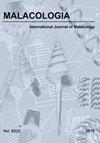A Phylogenetic Overview of the Genus Vertigo O. F. Müller, 1773 (Gastropoda: Pulmonata: Pupillidae: Vertigininae)
IF 1
4区 生物学
Q4 ZOOLOGY
引用次数: 26
Abstract
ABSTRACT We document global phylogenetic pattern in the pupillid land snail genus Vertigo by analyses of nDNA (ITS1 and ITS2) and mtDNA (CytB and 16S) sequence from 424 individuals representing 91 putative specific and subspecific Vertigo taxa. nDNA and mtDNA data were separately subjected to neighbor-joining, minimum evolution, maximum likelihood and Bayesian reconstruction methods, with conclusions being drawn from shared topological structures. Six highly supported, reciprocally monophyletic subgeneric level clades were identified: Vertigo, Alaea, Boreovertigo new subgenus, Isthmia, Staurodon and Vertilla. 88 species or subspecies were also confirmed, nine of which are new and formally described herein: V. beringiana, V. chiricahuensis, V. chytryi, V. genesioides, V. kodamai, V. kurilensis, V. lilljeborgi vinlandica, V. pimuensis and V. pisewensis. Thirteen taxa were synonymized: V. arthuri basidens, V. arthuri hubrichti, V. arthuri paradoxa (= V. arthuri); V. allyniana (= V. modesta); V. andrusiana (= V. columbiana); V. conecuhensis (= V. alabamensis); V. dedecora tamagonari (= V. dedecora); V. elatior, V. idahoensis (= V. ventricosa); V. eogea (= V. ovata); V. modesta insculpta (= V. modesta concinnula), V. modesta microphasma, V. modesta sculptilis (= V. modesta castanea). Qualitative observations of conchological features, ecological preferences and geographic coverage were conducted for each subgenus and genetically supported species or subspecies-level taxon. These demonstrated that: (1) a suite of diagnostic shell features usually exists to demarcate each species-level taxon; (2) shell features were incapable of defining genetically validated subgenera; (3) all subgenera had transcontinental ranges; (4) ⅓ of all species possess continental or trans-continental ranges, with very few having range extents < 1,000 km; (5) all subgenera and fully ⅔ of global Vertigo species and subspecies are found in North America, more than 2.5 times the number found in central and eastern Asia, the second most diverse region. This is similar to several other molluscan groups, such as the polygyrid land snails and unionid bivalves for which North America is the global biodiversity hotspot.Vertigo O. F. m ller, 1773的系统发育综述(腹足目:肺足目:瞳足科:眩晕科)
摘要:我们通过分析来自91个推测的Vertigo特异性和亚特异性分类群的424个个体的nDNA (ITS1和ITS2)和mtDNA (CytB和16S)序列,记录了眩晕螺属的全球系统发育模式。nDNA和mtDNA数据分别采用邻居连接、最小进化、最大似然和贝叶斯重建方法,从共享的拓扑结构中得出结论。鉴定出了眩晕、Alaea、Boreovertigo新亚属、Isthmia、Staurodon和Vertilla 6个高度支持、相互独立的亚属水平分支。另外还鉴定出了88个新种或亚种,其中9个为本文正式描述的新种或亚种:V. beringiana、V. chiricahuensis、V. chytryi、V. genesioides、V. kodamai、V. kurilensis、V. lilljeborgi vinlandica、V. pimuensis和V. pisewensis。13个分类群同名化:basidens . arthuri, hubrichti . arthuri, paradoxa . arthuri;V. allyniana (= V. modesta);安德鲁西弧菌(=哥伦比亚弧菌);紫锥虫(V. conecuhensis);dedecora tamagonari (= V. dedecora);V. relation, V. idahoensis (= V. ventricular);V. ogea (= V. ovata);雕花紫藓(=紫藓coninnula),微phasma紫藓,雕花紫藓(=紫藓castanea)。对每个亚属和遗传支持的种或亚种级分类单元进行了心理特征、生态偏好和地理覆盖度的定性观察。这些结果表明:(1)通常存在一套诊断性的贝壳特征来划分每个种级分类群;(2)外壳特征不能定义遗传验证的亚属;(3)所有亚属均有跨大陆分布;(4)三分之一的物种分布在大陆或跨大陆范围内,很少有物种的分布范围小于1000公里;(5)全球眩晕病的所有亚属和三分之二的种和亚种分布在北美,是中亚和东亚发现的数量的2.5倍以上,是第二多的地区。这与其他几个软体动物类群类似,比如北美是全球生物多样性热点的多格陆蜗牛和联合双壳类。
本文章由计算机程序翻译,如有差异,请以英文原文为准。
求助全文
约1分钟内获得全文
求助全文
来源期刊

Malacologia
生物-动物学
CiteScore
2.00
自引率
0.00%
发文量
15
审稿时长
3 months
期刊介绍:
Malacologia publishes papers on all groups of the Mollusca. Malacologia specializes in publishing long papers and monographic treatments. Complete data are especially appreciated. Papers must be of interest to an international readership. Papers in systematics, ecology, population ecology, genetics, molecular genetics, evolution and phylogenetic treatments are especially welcomed. Also welcomed are letters to the editor involving papers published or issues of import to science of the day.
 求助内容:
求助内容: 应助结果提醒方式:
应助结果提醒方式:


